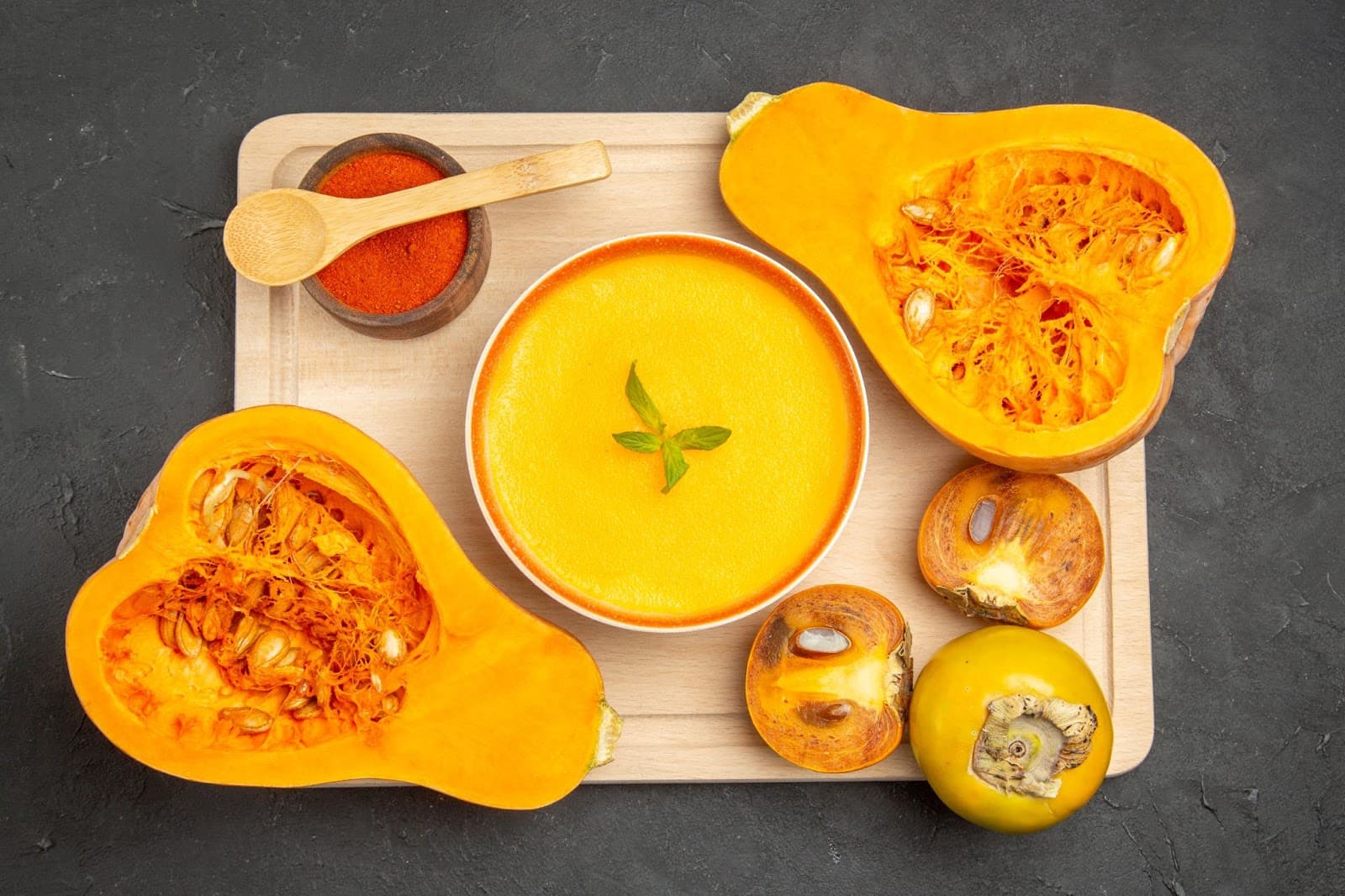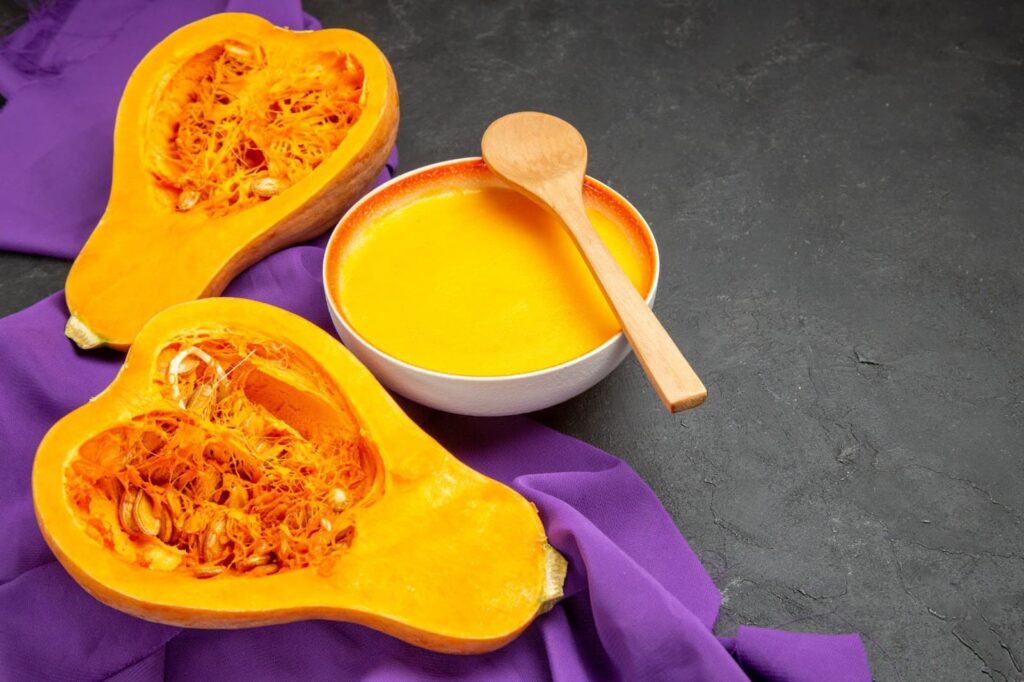
Embarking on a gustatory voyage through the essence of autumn’s abundance, we immerse ourselves in the opulent and grounded realm of squash, with a focus on two lesser-known yet equally delightful types: Kabocha and Buttercup. This piece, titled “Kabocha versus Buttercup Squash Puree,” acquaints readers with these lively treasures of the harvest, leading them through the subtleties that set each variety apart. We shall delve into their distinct tastes, textures, and nutritional profiles, offering insights into how these squash variants can metamorphose into lavish purees, transforming ordinary meals into seasonal revelries. From handpicking the ideal squash to mastering the technique of pureeing, we shall unveil the mysteries behind unlocking their inherent sweetness and velvety consistency, ensuring a culinary escapade that harmonizes simplicity with refinement.
Ingredients for the Ultimate Autumn Treat: Kabocha Puree
Crafting a delightful kabocha puree requires nothing more than a handful of easy-to-find, fresh ingredients. While kabocha squash is the star of the show, it’s the complementary ingredients that truly allow its flavor to shine. Note that the quantities are sufficient to create a sumptuous puree that can serve six to eight people, perfect for a family gathering or a party with friends.
Here’s everything you’ll need for this simple yet scrumptious kabocha puree recipe:
- One Kabocha squash or Buttercup squash, weighing approximately 3 pounds. The flavor of these squashes is incredibly similar, so you can choose based on availability.
- Half a cup of water. This is essential for simmering the squash and making the puree’s texture perfect.
- Half a cup of packed brown sugar. This ingredient adds a delightful sweetness that pairs wonderfully with the natural flavors of the squash.
- Three tablespoons of melted butter. It contributes to a silky-smooth texture in the puree and enhances the overall flavor.
- Three-quarters of a teaspoon of salt. This helps to bring out the sweetness and creates a beautiful balance of flavors.
- A quarter teaspoon of freshly ground black pepper. A subtle kick from black pepper enhances the puree’s taste.
- An optional dash of your favorite autumn spice, such as nutmeg, cinnamon, or cloves. Adding one of these spices can provide an extra layer of warmth and comfort to the dish, embodying the spirit of autumn.
Remember, these are the basic ingredients. Feel free to experiment with different spices or sweeteners to make this kabocha puree recipe truly your own. Each component plays its role in creating a vibrant, sweet, and wonderfully textured puree that impeccably captures the essence of fall. Enjoy this perfect dish on cozy autumn nights, or serve it as a delightful side for Thanksgiving dinner.
A Step-By-Step Guide to Making Savory Kabocha Puree
Let’s get started on crafting your mouth-watering homemade kabocha puree. The process is straightforward and requires only a few steps. Be ready to immerse yourself in an autumnal culinary experience that not only fills your kitchen with a waft of sweet, earthy aroma but also provides a comforting, nutritious dish on your dining table.

Here’s the detailed procedure to get that creamy, delicious kabocha puree at home:
- Preheat Your Oven: Set your oven to preheat to a temperature of 450 degrees Fahrenheit (232 degrees Celsius). Ensuring your oven is adequately heated before baking will provide accurate and even cooking.
- Prepare the Squash: Take the 3-pound Kabocha or Buttercup squash and cut it in half. Safely discard the seeds using a spoon; you don’t need them for this recipe.
- Set to Bake: Place the squash halves, cut sides down, in a 13 x 9-inch glass or ceramic baking dish. Glass and ceramic materials are the best for baking as they retain heat well and provide even cooking. Next, add 1/2 cup of water to your dish. The water will steam inside the oven, ensuring the squash becomes tender without losing any moisture.
- Bake: Cover the baking dish and bake at 450 degrees for 40 minutes or until the squash is tender. You can check the tenderness by inserting a fork into the squash; it should pierce easily.
- Let it Cool: After removing the squash from the oven, let it stand for about 10 minutes. This helps to cool down the squash, making it safer and easier to handle in the next steps.
- Extract the Pulp: Remove the pulp from the skin and discard the skin. The skin of the Kabocha squash is quite tough and isn’t suitable for the puree. Don’t worry about getting all the pulp out; a little left behind simply adds extra flavor!
- Add Remaining Ingredients and Puree: Combine the squash pulp, 1/2 cup of packed brown sugar, and the remaining ingredients in a food processor. The brown sugar adds a pleasant sweetness to the dish, while salt and black pepper add a savory note. If you’d like, add a dash of your favorite autumn spice, such as nutmeg, cinnamon, or cloves, to enhance and personalize the flavor further. Process this mixture until it’s smooth and devoid of lumps.
Your kitchen should now be filled with the sweet aroma of this delightful kabocha puree. This can be used in a variety of dishes, or savored just the way it is! Enjoy the taste of autumn in your home with this delicious, comforting, and easy-to-make homemade kabocha puree.
Conclusion
Buttercup squash puree, alternatively referred to as Kabocha squash puree, proves to be a highly adaptable element suitable for incorporation into a wide array of both sweet and savory culinary creations. Its inherent sweetness and velvety consistency render it a delightful enhancement to soups, sauces, accompaniments, and even various baked delicacies. Regardless of whether you opt to roast or steam your Kabocha squash, the resultant puree serves as a nutritious and flavorsome foundation for an abundance of gastronomic innovations. Hence, the next time you seek to infuse a touch of autumnal charm into your meals, contemplate preparing a batch of Kabocha squash puree; rest assured, you shall not be disappointed!